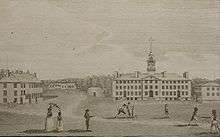Dartmouth College
Dartmouth College (/ˈdɑːrtməθ/ DART-məth) is a private Ivy League research university in Hanover, New Hampshire, United States. Established in 1769 by Eleazar Wheelock, it is the ninth-oldest institution of higher education in the United States and one of the nine colonial colleges chartered before the American Revolution.[8] Although founded as a school to educate Native Americans in Christian theology and the English way of life, Dartmouth primarily trained Congregationalist ministers throughout its early history before it gradually secularized, emerging at the turn of the 20th century from relative obscurity into national prominence.[9][10][11][12][13][14][15]
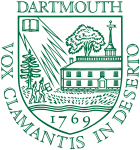 | |
| Latin: Collegium Dartmuthense | |
| Motto | Latin: Vox clamantis in deserto |
|---|---|
Motto in English | "A voice crying out in the wilderness"[1] |
| Type | Private research university |
| Established | December 13, 1769[2] |
Academic affiliations | |
| Endowment | $5.73 billion (2019)[3] |
| President | Philip J. Hanlon |
| Provost | Joseph Helble[4] |
Academic staff | 943 (Fall 2018)[1] |
Administrative staff | 2,938 full time, 328 part time (Fall 2018)[5] |
| Students | 6,608 (Fall 2019)[6] |
| Undergraduates | 4,459 (Fall 2019)[6] |
| Postgraduates | 2,149 (Fall 2019)[6] |
| Location | , , United States 43°42′12″N 72°17′18″W |
| Campus | Rural, college town; total 31,869 acres (128.97 km2) |
| Academic term | Quarter |
| Colors | Dartmouth green[7] |
| Nickname | Big Green |
Sporting affiliations | NCAA Division I – Ivy League, ECAC Hockey |
| Website | dartmouth |
Following a liberal arts curriculum, the university provides undergraduate instruction in 40 academic departments and interdisciplinary programs including 57 majors in the humanities, social sciences, natural sciences, and engineering, and enables students to design specialized concentrations or engage in dual degree programs.[16] Dartmouth comprises five constituent schools: the original undergraduate college, the Geisel School of Medicine, the Thayer School of Engineering, the Tuck School of Business, and the Guarini School of Graduate and Advanced Studies.[17] The university also has affiliations with the Dartmouth–Hitchcock Medical Center, the Rockefeller Institute for Public Policy, and the Hopkins Center for the Arts. With a student enrollment of about 6,600, Dartmouth is the smallest university in the Ivy League. Undergraduate admissions are highly competitive, with an acceptance rate of 8.8% for the Class of 2024.[18]
Situated on a terrace above the Connecticut River, Dartmouth's 269-acre main campus is in the rural Upper Valley region of New England.[19] The university functions on a quarter system, operating year-round on four ten-week academic terms.[20] Dartmouth is known for its undergraduate focus, strong Greek culture, and wide array of enduring campus traditions.[21][22][23] Its 34 varsity sports teams compete intercollegiately in the Ivy League conference of the NCAA Division I.
Dartmouth is consistently included among the highest-ranked universities in the United States by several institutional rankings,[24] and has been cited as a leading university for undergraduate teaching and research by U.S. News & World Report.[25][26] In 2018, the Carnegie Classification of Institutions of Higher Education listed Dartmouth as the only "majority-undergraduate", "arts-and-sciences focused", "doctoral university" in the country that has "some graduate coexistence" and "very high research activity".[27]
In its history, the university has produced many prominent alumni, including 170 members of the U.S. Senate and the U.S. House of Representatives,[28] 24 U.S. governors, 10 billionaire alumni,[29] 10 U.S. Cabinet secretaries, 3 Nobel Prize laureates, 2 U.S. Supreme Court justices, and a U.S. vice president. Other notable alumni include 79 Rhodes Scholars,[30] 26 Marshall Scholarship recipients,[31] 13 Pulitzer Prize winners, and numerous MacArthur Genius fellows,[32] Fulbright Scholars,[33] CEOs and founders of Fortune 500 corporations, high-ranking U.S. diplomats, scholars in academia, literary and media figures, professional athletes, and Olympic medalists.
History
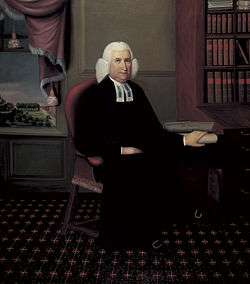
Dartmouth was founded by Eleazar Wheelock, a Congregational minister from Columbia, Connecticut, who had sought to establish a school to train Native Americans as Christian missionaries. Wheelock's ostensible inspiration for such an establishment resulted from his relationship with Mohegan Indian Samson Occom. Occom became an ordained minister after studying under Wheelock from 1743 to 1747, and later moved to Long Island to preach to the Montauks.[9]
Wheelock founded Moor's Indian Charity School in 1755.[34] The Charity School proved somewhat successful, but additional funding was necessary to continue school's operations, and Wheelock sought the help of friends to raise money. The first major donation to the school was given by John Phillips in 1762, who would go on to found Phillips Exeter Academy. Occom, accompanied by the Reverend Nathaniel Whitaker, traveled to England in 1766 to raise money from churches. With these funds, they established a trust to help Wheelock.[9] The head of the trust was a Methodist named William Legge, 2nd Earl of Dartmouth.
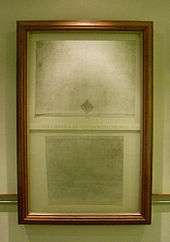
Although the fund provided Wheelock ample financial support for the Charity School, Wheelock initially had trouble recruiting Indians to the institution, primarily because its location was far from tribal territories. In seeking to expand the school into a college, Wheelock relocated it to Hanover, in the Province of New Hampshire. The move from Connecticut followed a lengthy and sometimes frustrating effort to find resources and secure a charter. The Royal Governor of New Hampshire, John Wentworth, provided the land upon which Dartmouth would be built and on December 13, 1769, issued a royal charter in the name of King George III establishing the College. That charter created a college "for the education and instruction of Youth of the Indian Tribes in this Land in reading, writing & all parts of Learning which shall appear necessary and expedient for civilizing & christianizing Children of Pagans as well as in all liberal Arts and Sciences and also of English Youth and any others". The reference to educating Native American youth was included to connect Dartmouth to the Charity School and enable use of the Charity School's unspent trust funds. Named for William Legge, 2nd Earl of Dartmouth—an important supporter of Eleazar Wheelock's earlier efforts but who, in fact, opposed creation of the College and never donated to it—Dartmouth is the nation's ninth oldest college and the last institution of higher learning established under Colonial rule.[10] The College granted its first degrees in 1771.[11]
Given the limited success of the Charity School, however, Wheelock intended his new college as one primarily for whites.[9][35] Occom, disappointed with Wheelock's departure from the school's original goal of Indian Christianization, went on to form his own community of New England Indians called Brothertown Indians in New York.[9][35]
In 1819, Dartmouth College was the subject of the historic Dartmouth College case, which challenged New Hampshire's 1816 attempt to amend the college' charter to make the school a public university. An institution called Dartmouth University occupied the college buildings and began operating in Hanover in 1817, though the college continued teaching classes in rented rooms nearby.[9] Daniel Webster, an alumnus of the class of 1801, presented the College's case to the Supreme Court, which found the amendment of Dartmouth's charter to be an illegal impairment of a contract by the state and reversed New Hampshire's takeover of the college. Webster concluded his peroration with the famous words: "It is, Sir, as I have said, a small college. And yet there are those who love it."[9]
Dartmouth taught its first African-American students in 1775 and 1808. By the end of the Civil War, 20 black men had attended the college or its medical school.[37] and Dartmouth "was recognized in the African-American community as a place where a man of color could go to get educated".[38] One of them, Jonathan C. Gibbs, served as Secretary of State and Superintendent of Public Instruction for the state of Florida.
In 1866, the New Hampshire College of Agriculture and the Mechanic Arts was incorporated in Hanover, in connection with Dartmouth College. The institution was officially associated with Dartmouth and was directed by Dartmouth's president. The new college was moved to Durham, New Hampshire, in 1891, and later became known as the University of New Hampshire.[39]
Dartmouth emerged onto the national academic stage at the turn of the 20th century. Prior to this period, the college had clung to traditional methods of instruction and was relatively poorly funded.[12] Under President William Jewett Tucker (1893–1909), Dartmouth underwent a major revitalization of facilities, faculty, and the student body, following large endowments such as the $10,000 given by Dartmouth alumnus and law professor John Ordronaux.[40] 20 new structures replaced antiquated buildings, while the student body and faculty both expanded threefold. Tucker is often credited for having "refounded Dartmouth" and bringing it into national prestige.[41]
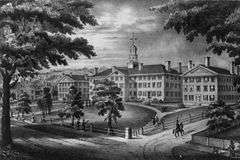
Presidents Ernest Fox Nichols (1909–16) and Ernest Martin Hopkins (1916–45) continued Tucker's trend of modernization, further improving campus facilities and introducing selective admissions in the 1920s.[12] In 1945, Hopkins was subject to no small amount of controversy, as he openly admitted to Dartmouth's practice of using racial quotas to deny Jews entry into the university.[42][43] John Sloan Dickey, serving as president from 1945 until 1970, strongly emphasized the liberal arts, particularly public policy and international relations.[12][44] During World War II, Dartmouth was one of 131 colleges and universities nationally that took part in the V-12 Navy College Training Program which offered students a path to a navy commission.
In 1970, longtime professor of mathematics and computer science John George Kemeny became president of Dartmouth.[46] Kemeny oversaw several major changes at the college. Dartmouth, which had been a men's institution, began admitting women as full-time students and undergraduate degree candidates in 1972 amid much controversy.[47] At about the same time, the college adopted its "Dartmouth Plan" of academic scheduling, permitting the student body to increase in size within the existing facilities.[46] In 1988, Dartmouth's alma mater song's lyrics changed from "Men of Dartmouth" to "Dear old Dartmouth".[48]
During the 1990s, the college saw a major academic overhaul under President James O. Freedman and a controversial (and ultimately unsuccessful) 1999 initiative to encourage the school's single-sex Greek houses to go coed.[12][49] The first decade of the 21st century saw the commencement of the $1.3 billion Campaign for the Dartmouth Experience, the largest capital fundraising campaign in the college's history, which surpassed $1 billion in 2008.[50][51] The mid- and late first decade of the 21st century have also seen extensive campus construction, with the erection of two new housing complexes, full renovation of two dormitories, and a forthcoming dining hall, life sciences center, and visual arts center.[52] In 2004, Booz Allen Hamilton selected Dartmouth College as a model of institutional endurance "whose record of endurance has had implications and benefits for all American organizations, both academic and commercial", citing Dartmouth College v. Woodward and Dartmouth's successful self-reinvention in the late 19th century.[13]
Since the election of a number of petition-nominated trustees to the Board of Trustees starting in 2004, the role of alumni in Dartmouth governance has been the subject of ongoing conflict.[53] President James Wright announced his retirement in February 2008[54] and was replaced by Harvard University professor and physician Jim Yong Kim on July 1, 2009.[55]
In May 2010 Dartmouth joined the Matariki Network of Universities (MNU) together with Durham University (UK), Queen's University (Canada), University of Otago (New Zealand), University of Tübingen (Germany), University of Western Australia (Australia) and Uppsala University (Sweden).[56]
In early August 2019, Dartmouth College agreed to pay nine current and former students a total of $14 million to settle a class-action lawsuit alleging they were sexually harassed by three former neuroscience professors.[57]
In 2019, Dartmouth College was elected to the Association of American Universities (AAU).[58]
Academics
Dartmouth, a liberal arts institution, offers a four-year Bachelor of Arts and ABET-accredited Bachelor of Engineering degree to undergraduate students.[8][59] The college has 39 academic departments offering 56 major programs, while students are free to design special majors or engage in dual majors.[60] For the graduating class of 2017, the most popular majors were economics, government, computer science, engineering sciences, and history.[61] The Government Department, whose prominent professors include Stephen Brooks, Richard Ned Lebow, and William Wohlforth, was ranked the top solely undergraduate political science program in the world by researchers at the London School of Economics in 2003.[62] The Economics Department, whose prominent professors include David Blanchflower and Andrew Samwick, also holds the distinction as the top-ranked bachelor's-only economics program in the world.[63]
In order to graduate, a student must complete 35 total courses, eight to ten of which are typically part of a chosen major program.[64] Other requirements for graduation include the completion of ten "distributive requirements" in a variety of academic fields, proficiency in a foreign language, and completion of a writing class and first-year seminar in writing.[64] Many departments offer honors programs requiring students seeking that distinction to engage in "independent, sustained work", culminating in the production of a thesis.[64] In addition to the courses offered in Hanover, Dartmouth offers 57 different off-campus programs, including Foreign Study Programs, Language Study Abroad programs, and Exchange Programs.[65][66]
Through the Graduate Studies program, Dartmouth grants doctorate and master's degrees in 19 Arts & Sciences graduate programs. Although the first graduate degree, a PhD in classics, was awarded in 1885, many of the current PhD programs have only existed since the 1960s.[8] Furthermore, Dartmouth is home to three professional schools: the Geisel School of Medicine (established 1797), Thayer School of Engineering (1867)—which also serves as the undergraduate department of engineering sciences—and Tuck School of Business (1900). With these professional schools and graduate programs, conventional American usage would accord Dartmouth the label of "Dartmouth University";[8] however, because of historical and nostalgic reasons (such as Dartmouth College v. Woodward), the school uses the name "Dartmouth College" to refer to the entire institution.[9]
Dartmouth employs a total of 607 tenured or tenure-track faculty members, including the highest proportion of female tenured professors among the Ivy League universities.[8] Faculty members have been at the forefront of such major academic developments as the Dartmouth Workshop, the Dartmouth Time Sharing System, Dartmouth BASIC, and Dartmouth ALGOL 30. In 2005, sponsored project awards to Dartmouth faculty research amounted to $169 million.[67]
Dartmouth serves as the host institution of the University Press of New England, a university press founded in 1970 that is supported by a consortium of schools that also includes Brandeis University, the University of New Hampshire, Northeastern University, Tufts University and the University of Vermont.[68]
Rankings
| University rankings | |
|---|---|
| National | |
| ARWU[69] | 95–116 |
| Forbes[70] | 10 |
| THE/WSJ[71] | 12 |
| U.S. News & World Report[72] | 12 |
| Washington Monthly[73] | 34 |
| Global | |
| ARWU[74] | 301–400 |
| QS[75] | 203 |
| THE[76] | 94 |
| U.S. News & World Report[77] | 214 |
|
USNWR graduate school rankings[78] | |
|---|---|
| Business | 12 |
| Engineering | 56 |
| Medicine: Primary Care | 19 |
| Medicine: Research | 50 |
|
USNWR departmental rankings[78] | |
|---|---|
| Biological Sciences | 33 |
| Chemistry | 67 |
| Computer Science | 43 |
| Earth Sciences | 54 |
| Mathematics | 53 |
| Physics | 61 |
| Psychology | 53 |
| Public Health | 46 |
Dartmouth was ranked tied for 12th among undergraduate programs at national universities by U.S. News & World Report in its 2020 rankings. U.S. News also ranked the school 2nd best for veterans, tied for 5th best in undergraduate teaching, and 9th for "best value" at national universities in 2020.[79] Dartmouth's undergraduate teaching was previously ranked 1st by U.S. News for five years in a row (2009–2013).[80]
In Forbes' 2019 rankings of 650 universities, liberal arts colleges and service academies, Dartmouth ranked 10th overall and 10th in research universities.[81] In the Forbes 2018 "grateful graduate" rankings, Dartmouth came in first for the second year in a row.[82]
The 2020 Academic Ranking of World Universities ranked Dartmouth among the 95–116th best universities in the nation.[83] However, this specific ranking has drawn criticism from scholars for not adequately adjusting for the size of an institution, which leads to larger institutions ranking above smaller ones like Dartmouth.[84] Similarly, Dartmouth's small size and its undergraduate focus disadvantage its ranking in international rankings because international ranking organizations use formulas that favor institutions with a large number of graduate students.[85]
The 2006 Carnegie Foundation classification listed Dartmouth as the only "majority-undergraduate", "arts-and-sciences focus[ed]", "research university" in the country that also had "some graduate coexistence" and "very high research activity".[86][87][88]
Admissions
| Admissions statistics (2019)[89][90] | |
|---|---|
| Parentheses denote change since 2014. | |
| Admit rate | 7.9% ( |
| Yield rate | 63.6% ( |
| Test scores middle 50% | |
| ACT Composite | 32–35 |
Undergraduate admission to Dartmouth College is characterized by the Carnegie Foundation and U.S. News & World Report as "most selective".[91][92] The Princeton Review, in its 2018 edition, gave the university an admissions selectivity rating of 98 out of 99.[93]
For the freshman class entering Fall 2020, Dartmouth received 21,394 applications of which 1,881 were accepted for an 8.8% admissions rate. Of those admitted students who reported class rank, 96% ranked in the top decile of their class. The admitted students' academic profile showed an all-time high SAT average score of 1501, while the average composite ACT score remained at 33.[94]
Additionally, for the 2016–2017 academic year, Dartmouth received 685 transfer applications of which 5.1% were accepted, with an average SAT composite score of 1490, average composite ACT score of 34, and average college GPA of about 3.85.[95] Dartmouth meets 100% of students' demonstrated financial need in order to attend the College, and currently admits all students, with the exception of internationals, on a need-blind basis.[96]
Financial aid
Dartmouth guarantees to meet 100% of the demonstrated need of every admitted student who applies for financial aid at the time of admission. Dartmouth practices need-blind admissions for all applicants who are U.S. citizens, permanent residents, and undocumented students in the U.S. These applicants are admitted to the college without regard to their financial circumstances. For international students, financial need is taken into consideration as one of many factors at the time of admission. At Dartmouth, free tuition is provided for students from families with total incomes of $100,000 or less and possessing typical assets. In 2015, $88.8 million in need-based scholarships were awarded to Dartmouth students.
The median family income of Dartmouth students is $200,400, with 58% of students coming from the top 10% highest-earning families and 14% from the bottom 60%.[97]
The Dartmouth Plan
Dartmouth functions on a quarter system, operating year-round on four ten-week academic terms. The Dartmouth Plan (or simply "D-Plan") is an academic scheduling system that permits the customization of each student's academic year. All undergraduates are required to be in residence for the fall, winter, and spring terms of their freshman and senior years, as well as the summer term of their sophomore year.[98] However, students may petition to alter this plan so that they may be off during their freshman, senior, or sophomore summer terms.[99] During all terms, students are permitted to choose between studying on-campus, studying at an off-campus program, or taking a term off for vacation, outside internships, or research projects.[98] The typical course load is three classes per term, and students will generally enroll in classes for 12 total terms over the course of their academic career.[100]
The D-Plan was instituted in the early 1970s at the same time that Dartmouth began accepting female undergraduates. It was initially devised as a plan to increase the enrollment without enlarging campus accommodations, and has been described as "a way to put 4,000 students into 3,000 beds".[12] Although new dormitories have been built since, the number of students has also increased and the D-Plan remains in effect. It was modified in the 1980s in an attempt to reduce the problems of lack of social and academic continuity.
Board of Trustees
Dartmouth is governed by a Board of Trustees comprising the college president (ex officio), the state governor (ex officio), 13 trustees nominated and elected by the board (called "charter trustees"), and eight trustees nominated by alumni and elected by the board ("alumni trustees").[101] The nominees for alumni trustee are determined by a poll of the members of the Association of Alumni of Dartmouth College, selecting from among names put forward by the Alumni Council or by alumni petition.
Although the board elected its members from the two sources of nominees in equal proportions between 1891 and 2007,[102] the board decided in 2007 to add several new members, all charter trustees.[103] In the controversy that followed the decision, the Association of Alumni filed a lawsuit, although it later withdrew the action.[104][105] In 2008, the Board added five new charter trustees.[106]
Campus
—U.S. President Dwight D. Eisenhower, 1953[107]
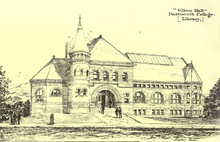
Dartmouth College is situated in the rural town of Hanover, New Hampshire, located in the Upper Valley along the Connecticut River in New England. Its 269-acre (1.09 km2) campus is centered on a 5-acre (2 ha) "Green",[108] a former field of pine trees cleared in 1771.[109] Dartmouth is the largest private landowner of the town of Hanover,[110] and its total landholdings and facilities are worth an estimated $434 million.[111] In addition to its campus in Hanover, Dartmouth owns 4,500 acres (18 km2) of Mount Moosilauke in the White Mountains[112] and a 27,000-acre (110 km2) tract of land in northern New Hampshire known as the Second College Grant.[113]
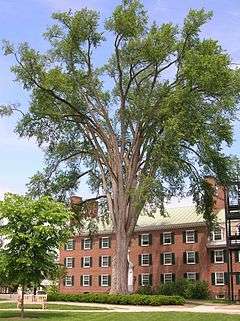
Dartmouth's campus buildings vary in age from Wentworth and Thornton Halls of the 1820s (the oldest surviving buildings constructed by the college) to new dormitories and mathematics facilities completed in 2006.[114][115] Most of Dartmouth's buildings are designed in the Georgian colonial architecture style,[116][117][118] a theme which has been preserved in recent architectural additions.[119] The College has actively sought to reduce carbon emissions and energy usage on campus, earning it the grade of A- from the Sustainable Endowments Institute on its College Sustainability Report Card 2008.[120][121]
A notable feature of the Dartmouth campus is its many trees which (despite Dutch elm disease) include some 200 American elms.[122][123]
Academic facilities

The college's creative and performing arts facility is the Hopkins Center for the Arts ("the Hop"). Opened in 1962, the Hop houses the College's drama, music, film, and studio arts departments, as well as a woodshop, pottery studio, and jewelry studio which are open for use by students and faculty.[124] The building was designed by the famed architect Wallace Harrison, who would later design the similar-looking façade of Manhattan's Metropolitan Opera House at Lincoln Center.[125] Its facilities include two theaters and one 900-seat auditorium.[124] The Hop is also the location of all student mailboxes ("Hinman boxes")[126] and the Courtyard Café dining facility.[127] The Hop is connected to the Hood Museum of Art, arguably North America's oldest museum in continuous operation,[128] and the Loew Auditorium, where films are screened.[129]
In addition to its 19 graduate programs in the arts and sciences, Dartmouth is home to three separate graduate schools. The Geisel School of Medicine is located in a complex on the north side of campus[130] and includes laboratories, classrooms, offices, and a biomedical library.[131] The Dartmouth–Hitchcock Medical Center, located several miles to the south in Lebanon, New Hampshire, contains a 396-bed teaching hospital for the Medical School.[132] The Thayer School of Engineering and the Tuck School of Business are both located at the end of Tuck Mall, west of the center of campus and near the Connecticut River.[131] The Thayer School comprises two buildings;[131] Tuck has seven academic and administrative buildings, as well as several common areas.[133] The two graduate schools share a library, the Feldberg Business & Engineering Library.[133]
Dartmouth's nine libraries are all part of the collective Dartmouth College Library, which comprises 2.48 million volumes and 6 million total resources, including videos, maps, sound recordings, and photographs.[8][134] Its specialized libraries include the Biomedical Libraries, Evans Map Room, Feldberg Business & Engineering Library, Jones Media Center, Kresge Physical Sciences Library, Paddock Music Library, Rauner Special Collections Library, and Sherman Art Library. Baker-Berry Library is the main library at Dartmouth, consisting of a merger of the Baker Memorial Library (opened 1928) and the Berry Library (completed 2002).[135] Located on the northern side of the Green, Baker's 200-foot (61 m) tower is an iconic symbol of the College.[136][137][138]
Athletic facilities
Dartmouth's original sports field was the Green, where students played cricket and old division football during the 19th century.[109] Today, two of Dartmouth's athletic facilities are located in the southeast corner of campus.[139] The center of athletic life is the Alumni Gymnasium, which includes the Karl Michael Competition Pool and the Spaulding Pool, a state of the art fitness center, a weight room, and a 1/13th-mile (123 m) indoor track.[140] Attached to Alumni Gymnasium is the Berry Sports Center, which contains basketball and volleyball courts (Leede Arena), as well as the Kresge Fitness Center.[141] Behind the Alumni Gymnasium is Memorial Field, a 15,600-seat stadium overlooking Dartmouth's football field and track.[142] The nearby Thompson Arena, designed by Italian engineer Pier Luigi Nervi and constructed in 1975, houses Dartmouth's ice rink.[143] Also visible from Memorial Field is the 91,800-square-foot (8,530 m2) Nathaniel Leverone Fieldhouse, home to the indoor track. The new softball field, Dartmouth Softball Park, was constructed in 2012, sharing parking facilities with Thompson arena and replacing Sachem Field, located over a mile from campus, as the primary softball facility.
Dartmouth's other athletic facilities in Hanover include the Friends of Dartmouth Rowing Boathouse and the old rowing house storage facility (both located along the Connecticut River), the Hanover Country Club, Dartmouth's oldest remaining athletic facility (established in 1899),[144] and the Corey Ford Rugby Clubhouse.[145] The college also maintains the Dartmouth Skiway, a 100-acre (0.40 km2) skiing facility located over two mountains near the Hanover campus in Lyme Center, New Hampshire,[146] that serves as the winter practice grounds for the Dartmouth ski team, which is a perennial contender for the NCAA Division I championship.
Dartmouth's close association and involvement in the development of the downhill skiing industry is featured in the 2010 book Passion for Skiing as well as the 2013 documentary based on the book Passion for Snow.[147]
Residential housing and student life facilities
Beginning in the fall term of 2016, Dartmouth placed all undergraduate students in one of six House communities, similar to residential colleges, including Allen House, East Wheelock House, North Park House, School House, South House, and West House, alongside independent Living Learning Communities.[148] Dartmouth used to have nine residential communities located throughout campus, instead of ungrouped dormitories or residential colleges.[149] The dormitories varied in design from modern to traditional Georgian styles, and room arrangements range from singles to quads and apartment suites.[149] Since 2006, the college has guaranteed housing for students during their freshman and sophomore years.[150] More than 3,000 students elect to live in housing provided by college.[149]
Campus meals are served by Dartmouth Dining Services, which operates 11 dining establishments around campus.[151] Four of them are located at the center of campus in the Class of 1953 Commons, formerly Thayer Dining Hall.[152]
The Collis Center is the center of student life and programming, serving as what would be generically termed the "student union" or "campus center".[153] It contains a café, study space, common areas, and a number of administrative departments, including the Academic Skills Centre.[154][155] Robinson Hall, next door to both Collis and Thayer, contains the offices of a number of student organizations including the Dartmouth Outing Club and The Dartmouth daily newspaper.[156]
- Lord Hall, Allen House
- Morton Hall, East Wheelock House
- Woodward Hall, North Park House
- Mid Massachusetts Hall, School House
- Topliff Hall, South House
- Russell Sage Hall, West House
- Cutter-Shabazz House for Intellectual Inquiry
Student life
In 2006, The Princeton Review ranked Dartmouth third in its "Quality of Life" category, and sixth for having the "Happiest Students".[157] Athletics and participation in the Greek system are the most popular campus activities.[21] In all, Dartmouth offers more than 350 organizations, teams, and sports.[158] The school is also home to a variety of longstanding traditions and celebrations and has a loyal alumni network; Dartmouth ranked #2 in "The Princeton Review" in 2006 for Best Alumni Network.[159]
Student safety
In 2014, Dartmouth College was the third highest in the nation in "total of reports of rape" on their main campus, with 42 reports of rape. The Washington Post attributed the high number of rape reports to the fact that a growing number of sexual assault victims feel comfortable enough to report sexual assaults that would have gone unreported in previous years.[160] In 2015, the Huffington Post reported that Dartmouth College had the highest rate of bystander intervention of any college surveyed, with 57.7% of Dartmouth students reporting that they would take some sort of action if they saw someone acting in a "sexually violent or harassing manner", compared to 45.5% of students nationally.
Dartmouth fraternities have an extensive history of hazing and alcohol abuse, leading to police raids and accusations of sexual harassment.[161][162]
Student groups
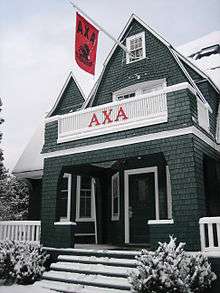
Dartmouth's more than 200 student organizations and clubs cover a wide range of interests.[163] In 2007, the college hosted eight academic groups, 17 cultural groups, two honor societies, 30 "issue-oriented" groups, 25 performing groups, 12 pre-professional groups, 20 publications, and 11 recreational groups.[164] Notable student groups include the nation's largest and oldest collegiate outdoors club, the Dartmouth Outing Club,[165] which includes the nationally recognized[166] Big Green Bus; the campus's oldest a cappella group, The Dartmouth Aires; the controversial conservative newspaper The Dartmouth Review;[167] and The Dartmouth, arguably the nation's oldest university newspaper.[168] The Dartmouth describes itself as "America's Oldest College Newspaper, Founded 1799".[168]
Partially because of Dartmouth's rural, isolated location, the Greek system dating from the 1840s is one of the most popular social outlets for students.[21][169] Dartmouth is home to 32 recognized Greek houses: 17 fraternities, 12 sororities, and three coeducational organizations.[170] In 2007, roughly 70% of eligible students belonged to a Greek organization; since 1987, students have not been permitted to join Greek organizations until their sophomore year.[172] Dartmouth College was among the first institutions of higher education to desegregate fraternity houses in the 1950s, and was involved in the movement to create coeducational Greek houses in the 1970s.[173] In the early first decade of the 21st century, campus-wide debate focused on a Board of Trustees recommendation that Greek organizations become "substantially coeducational";[174] this attempt to change the Greek system eventually failed.[175]
Dartmouth also has a number of secret societies, which are student- and alumni-led organizations often focused on preserving the history of the college and initiating service projects. Most prominent among them is the Sphinx society, housed in a prominent Egyptian tomb-like building near the center of campus. The Sphinx has been the subject of numerous rumors as to its facilities, practices, and membership.[176]
The college has an additional classification of social/residential organizations known as undergraduate societies.[177]
Athletics
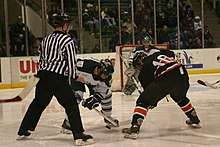
Approximately 20% of students participate in a varsity sport, and nearly 80% participate in some form of club, varsity, intramural, or other athletics.[178] In 2007, Dartmouth College fielded 34 intercollegiate varsity teams: 16 for men, 16 for women, and coeducational sailing and equestrian programs. Dartmouth's athletic teams compete in the National Collegiate Athletic Association (NCAA) Division I eight-member Ivy League conference; some teams also participate in the Eastern College Athletic Conference (ECAC).[179] As is mandatory for the members of the Ivy League, Dartmouth College does not offer athletic scholarships.[179][180] In addition to the traditional American team sports (football, basketball, baseball, and ice hockey), Dartmouth competes at the varsity level in many other sports including track and field, softball, squash, sailing, tennis, rowing, soccer, skiing, and lacrosse.[8]

The college also offers 26 club and intramural sports such as fencing, rugby, water polo, figure skating, boxing, volleyball, ultimate frisbee, and cricket, leading to a 75% participation rate in athletics among the undergraduate student body.[8][181] The Dartmouth Fencing Team, despite being entirely self-coached, won the USACFC club national championship in 2014.[182] The Dartmouth Men's Rugby Team, founded in 1951, has been ranked among the best collegiate teams in that sport, winning for example the Ivy Rugby Conference every year between 2008 and 2015.[183] The figure skating team won the national championship five straight times from 2004 through 2008.[184] In addition to the academic requirements for graduation, Dartmouth requires every undergraduate to complete a 50-yard (46 m) swim and three terms of physical education.[185]
Native Americans at Dartmouth
.jpg)
The charter of Dartmouth College, granted to Wheelock in 1769, proclaims that the institution was created "for the education and instruction of Youth of the Indian Tribes in this Land in reading, writing and all parts of Learning ... as well as in all liberal Arts and Sciences; and also of English Youth and any others".[186] However, Wheelock primarily intended the college to educate white youth, and the few Native students that attended Dartmouth experienced much difficulty in an institution ostensibly dedicated to their education. The funds for the Charity School for Native Americans that preceded Dartmouth College were raised primarily by the efforts of a Mohegan named Samson Occom, and at least some of those funds were used to help found the college.[187]
The college graduated only 19 Native Americans during its first 200 years.[187] In 1970, the college established Native American academic and social programs as part of a "new dedication to increasing Native American enrollment".[187] Since then, Dartmouth has graduated over 700 Native American students from over 200 different tribes, more than the other seven Ivy League universities combined.[187]
Traditions
Dartmouth is well known for its fierce school spirit and many traditions.[188] The college functions on a quarter system, and one weekend each term is set aside as a traditional celebratory event, known on campus as "big weekends"[189][190] or "party weekends".[191] In the fall term, Homecoming (officially called Dartmouth Night) is marked by a bonfire on the Green constructed by the freshman class.[192] Winter term is celebrated by Winter Carnival, a tradition started in 1911 by the Dartmouth Outing Club to promote winter sports. This tradition is the oldest in the United States, and subsequently went on to catch on at other New England colleges.[193][194] In the spring, Green Key is a weekend mostly devoted to campus parties and celebration.[195]
The summer term was formerly marked by Tubestock, an unofficial tradition in which the students used wooden rafts and inner tubes to float on the Connecticut River. Begun in 1986, Tubestock was ended in 2006 by town ordinance.[196] The Class of 2008, during their summer term on campus in 2006, replaced the defunct Tubestock with Fieldstock. This new celebration includes a barbecue, live music, and the revival of the 1970s and 1980s tradition of racing homemade chariots around the Green. Unlike Tubestock, Fieldstock is funded and supported by the College.[197]
Another longstanding tradition is four-day, student-run Dartmouth Outing Club trips for incoming freshmen, begun in 1935. Each trip concludes at the Moosilauke Ravine Lodge.[198] In 2011, over 96% of freshmen elected to participate.
Insignia and other representations
Motto and song
Dartmouth's motto, chosen by Eleazar Wheelock, is Vox clamantis in deserto. The Latin motto is literally translated as "A calling voice in the wilderness",[199][200] but is more often rendered as "A voice crying out in the wilderness".[1] The phrase appears five times in the Bible and is a reference to the college's location on what was once the frontier of European settlement.[200][201] Richard Hovey's "Men of Dartmouth" was elected as the best of Dartmouth's songs in 1896,[192] and became the school's official song in 1926.[202] The song was retitled to "Alma Mater" in the 1980s when its lyrics were changed to refer to women as well as men.[203]
Seal
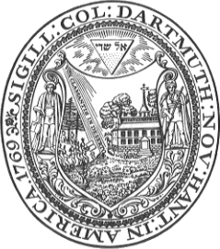
Dartmouth's 1769 royal charter required the creation of a seal for use on official documents and diplomas.[186] The college's founder, Eleazar Wheelock, designed a seal for his college bearing a striking resemblance to the seal of the Society for the Propagation of the Gospel, a missionary society founded in London in 1701, in order to maintain the illusion that his college was more for mission work than for higher education.[200] Engraved by a Boston silversmith, the seal was ready by commencement of 1773. The trustees officially accepted the seal on August 25, 1773, describing it as:
An Oval, circumscribed by a Line containing SIGILL: COL: DARTMUTH: NOV: HANT: IN AMERICA 1770. within projecting a Pine Grove on the Right, whence proceed Natives towards an Edifice two Storey on the left; which bears in a Label over the Grove these Words "vox clamantis in deserto" the whole supported by Religion on the Right and Justice on the Left, and bearing in a Triangle irradiate, with the Hebrew Words [El Shaddai], agreeable to the above Impression, be the common Seal under which to pass all Diplomas or Certificates of Degrees, and all other Affairs of Business of and concerning Dartmouth College.[204]
On October 28, 1926, the trustees affirmed the charter's reservation of the seal for official corporate documents alone.[200] The College Publications Committee commissioned noted typographer William Addison Dwiggins to create a line drawing version of the seal in 1940 that saw widespread use. Dwiggins' design was modified during 1957 to change the date from "1770" to "1769", to accord with the date of the college charter. The trustees commissioned a new set of dies with a date of "1769" to replace the old dies, now badly worn after almost two hundred years of use.[200] The 1957 design continues to be used under trademark number 2305032.[205]
Shield
On October 28, 1926, the trustees approved a "Dartmouth College Shield" for general use. Artist and engraver W. Parke Johnson designed this emblem on the basis of the shield that is depicted at the center of the original seal. This design does not survive. On June 9, 1944, the trustees approved another coat of arms based on the shield part of the seal, this one by Canadian artist and designer Thoreau MacDonald. That design was used widely and, like Dwiggins' seal, had its date changed from "1770" to "1769" around 1958.[200] That version continues to be used under trademark registration number 3112676 and others.[205]
College designer John Scotford made a stylized version of the shield during the 1960s, but it did not see the success of MacDonald's design.[206] The shield appears to have been used as the basis of the shield of Dartmouth Medical School, and it has been reproduced in sizes as small as 20 micrometers across.[207] The design has appeared on Rudolph Ruzicka's Bicentennial Medal (Philadelphia Mint, 1969) and elsewhere.
Nickname, symbol, and mascot
Dartmouth has never had an official mascot.[208] The nickname "The Big Green",[209] originating in the 1860s, is based on students' adoption of a shade of forest green ("Dartmouth Green") as the school's official color in 1866.[210][211] Beginning in the 1920s, the Dartmouth College athletic teams were known by their unofficial nickname "the Indians", a moniker that probably originated among sports journalists.[208] This unofficial mascot and team name was used until the early 1970s, when its use came under criticism. In 1974, the Trustees declared the "use of the [Indian] symbol in any form to be inconsistent with present institutional and academic objectives of the College in advancing Native American education".[212] Some alumni and students, as well as the conservative student newspaper, The Dartmouth Review, have sought to return the Indian symbol to prominence,[213] but never succeeded in doing so.[214]
Various student initiatives have been undertaken to adopt a mascot, but none has become "official". One proposal devised by the college humor magazine the Dartmouth Jack-O-Lantern was Keggy the Keg, an anthropomorphic beer keg who makes occasional appearances at college sporting events. Despite student enthusiasm for Keggy,[215] the mascot has received approval from only the student government.[216] In November 2006, student government attempted to revive the "Dartmoose" as a potential replacement amid renewed controversy surrounding the former unofficial Indian mascot.[217]
Alumni
Dartmouth's alumni are known for their devotion to the college.[218] Most start by giving to the Senior Class Gift. According to a 2008 article in The Wall Street Journal based on data from payscale.com, Dartmouth graduates also earn higher median salaries at least 10 years after graduation than alumni of any other American university surveyed.[219]
By 2008, Dartmouth had graduated 238 classes of students, and had over 60,000 living alumni in a variety of fields.[220]
Nelson A. Rockefeller, 41st Vice President of the United States and 49th Governor of New York, graduated cum laude from Dartmouth with a degree in economics in 1930. Over 164 Dartmouth graduates have served in the United States Senate and United States House of Representatives,[221] such as Massachusetts statesman Daniel Webster.[221] Cabinet members of American presidents include Attorney General Amos T. Akerman,[222] Secretary of Defense James V. Forrestal, Secretary of Labor Robert Reich,[223] Secretary of the Treasury Henry Paulson, and Secretary of the Treasury Timothy Geithner. C. Everett Koop was the Surgeon General of the United States under President Ronald Reagan.[224] Two Dartmouth alumni have served as justices on the Supreme Court of the United States: Salmon P. Chase and Levi Woodbury.[225][226] Eugene Norman Veasey (class of 1954) served as the Chief Justice of Delaware. The 46th Governor of Pennsylvania, Tom Wolf;[227] the 42nd Governor of Illinois, businessman Bruce Rauner;[228] and the 31st governor and current senator from North Dakota, John Hoeven (R), are also Dartmouth alumni. Ernesto de la Guardia, class of 1925, was president of the Republic of Panama.
In literature and journalism, Dartmouth has produced 13 Pulitzer Prize winners: Thomas M. Burton,[229] Richard Eberhart,[230] Dan Fagin,[231] Paul Gigot, Frank Gilroy, Jake Hooker,[232] Nigel Jaquiss,[233] Joseph Rago,[234] Martin J. Sherwin,[235] David K. Shipler,[236] David Shribman, Justin Harvey Smith and Robert Frost.[237] Frost, who received four Pulitzer Prizes for Poetry in his lifetime, attended but did not graduate from Dartmouth; he is, however, the only person to have received two honorary degrees from Dartmouth.[237]
Other authors and media personalities include ABC Senior White House correspondent Jake Tapper, novelist and founding editor of The Believer Heidi Julavits, "Dean of rock critics" Robert Christgau, National Book Award winners Louise Erdrich and Phil Klay, novelist/screenwriter Budd Schulberg,[238] political commentator Dinesh D'Souza,[239] radio talk show host Laura Ingraham,[240] commentator Mort Kondracke,[241] and journalist James Panero.[242] Norman Maclean, professor at the University of Chicago[243] and author of A River Runs Through It and Other Stories, graduated from Dartmouth in 1924.[244] Theodor Geisel, better known as children's author Dr. Seuss, was a member of the class of 1925.[245]
In the area of religion and theology, Dartmouth alumni include priests and ministers Ebenezer Porter, Jonathan Clarkson Gibbs, Caleb Sprague Henry, Arthur Whipple Jenks, Solomon Spalding, and Joseph Tracy; and rabbis Marshall Meyer, Arnold Resnicoff, and David E. Stern.[246][247][248][249][250] Hyrum Smith, brother of Mormon Prophet Joseph Smith, attended the college in his teens. He was Patriarch of the LDS Church.
Dartmouth alumni in academia include Stuart Kauffman and Jeffrey Weeks, both recipients of MacArthur Fellowships (commonly called "genius grants").[251][252] Dartmouth has also graduated three Nobel Prize winners: Owen Chamberlain (Physics, 1959),[253] K. Barry Sharpless (Chemistry, 2001),[254] and George Davis Snell (Physiology or Medicine, 1980).[255] Educators include founder and first president of Bates College Oren Burbank Cheney (1839);[256] the current chancellor of the University of California, San Diego, Marye Anne Fox (PhD. in Chemistry, 1974);[257] founding president of Vassar College Milo Parker Jewett;[258] founder and first president of Kenyon College Philander Chase;[259] first professor of Wabash College Caleb Mills;[260] and president of Union College Charles Augustus Aiken.[261][262] Nine of Dartmouth's 17 presidents were alumni of the college.[263]
Dartmouth alumni serving as CEOs or company presidents and executives include Charles Alfred Pillsbury, founder of the Pillsbury Company and patriarch of the Pillsbury family, Sandy Alderson (San Diego Padres),[264] John Donahoe (eBay), Louis V. Gerstner, Jr. (IBM),[265] Charles E. Haldeman (Putnam Investments),[266] Donald J. Hall Sr. (Hallmark Cards),[267] Douglas Hodge (CEO of PIMCO accused of fraud),[268] Jeffrey R. Immelt (General Electric),[269] Gail Koziara Boudreaux (United Health Care),[270] Grant Tinker (NBC),[271] and Brian Goldner (Hasbro).[272]
In film, entertainment, and television, Dartmouth is represented by David Benioff, co-creator, showrunner, and writer of Game of Thrones; Shonda Rhimes, creator of Grey's Anatomy, Private Practice and Scandal;[273] Budd Schulberg, Academy Award-winning screenwriter of On the Waterfront; Michael Phillips, who won the Academy Award for best picture as co-producer of The Sting; Rachel Dratch, a cast member of Saturday Night Live;[274] Chris Meledandri, executive producer of Ice Age, Horton Hears a Who!, and Despicable Me;[274] writer and director duo Phil Lord and Chris Miller; and the title character of Mister Rogers' Neighborhood, Fred Rogers.[275] Other notable film and television figures include Sarah Wayne Callies (Prison Break),[276] Emmy Award winner Michael Moriarty,[274] Andrew Shue of Melrose Place,[277] Aisha Tyler of Friends and 24,[274] Connie Britton of Spin City and Friday Night Lights, Mindy Kaling of The Office and The Mindy Project,[274] and David Harbour of Stranger Things.
A number of Dartmouth alumni have found success in professional sports. In baseball, Dartmouth alumni include All-Star and three-time Gold Glove winner and manager Brad Ausmus,[278] All-Star reliever Mike Remlinger,[279] and pitcher Kyle Hendricks. Professional football players include Miami Dolphins quarterback Jay Fiedler,[280] linebacker Reggie Williams,[281][282] three-time Pro Bowler Nick Lowery,[283] quarterback Jeff Kemp,[284] and Tennessee Titans tight end Casey Cramer, plus Miami Dolphins defensive coordinator Matt Burke.[285] Dartmouth has also produced a number of Olympic competitors. Adam Nelson won the silver medal in the shot put in the 2000 Sydney Olympics and the gold medal at the 2004 Athens Olympics to go along with his gold medal in the 2005 World Championships in Athletics in Helsinki.[286] Kristin King and Sarah Parsons were members of the United States' 2006 bronze medal-winning ice hockey team.[287][288] Cherie Piper, Gillian Apps, and Katie Weatherston were among Canada's ice hockey gold medalists in 2006.[289][290][291]
Dick Durrance and Tim Caldwell competed for the United States in skiing in the 1936 and 1976 Winter Olympics, respectively.[292][293] Arthur Shaw,[294] Earl Thomson,[295] Edwin Myers,[294] Marc Wright,[294] Adam Nelson,[286] Gerry Ashworth,[294] and Vilhjálmur Einarsson[294] have all won medals in track and field events. Former heavyweight rower Dominic Seiterle is a member of the Canadian national rowing team and won a gold medal at the 2008 Summer Olympics in the men's 8+ event.[296]
- Notable Dartmouth alumni include:
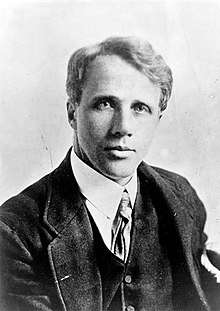 Robert Frost, poet
Robert Frost, poet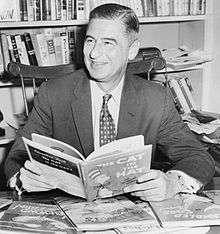 Dr. Seuss, writer and illustrator
Dr. Seuss, writer and illustrator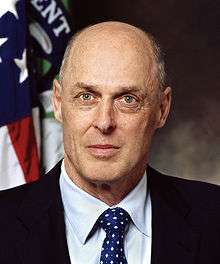
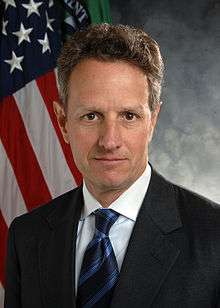
.jpg) Salmon Chase, former Chief Justice of the U.S.
Salmon Chase, former Chief Justice of the U.S.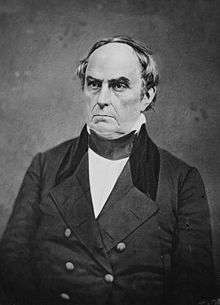 Daniel Webster, former Secretary of State
Daniel Webster, former Secretary of State
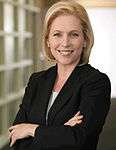 Kirsten Gillibrand, United States senator
Kirsten Gillibrand, United States senator- Robert Reich, former United States Secretary of Labor, political commentator, professor, and author
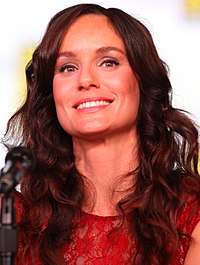 Sarah Wayne Callies, actress
Sarah Wayne Callies, actress Mindy Kaling, actress and comedian
Mindy Kaling, actress and comedian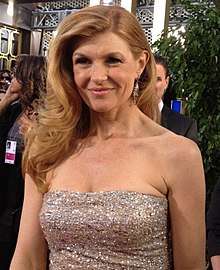 Connie Britton, actress, singer and producer
Connie Britton, actress, singer and producer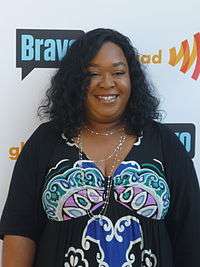 Shonda Rhimes, television producer and writer
Shonda Rhimes, television producer and writer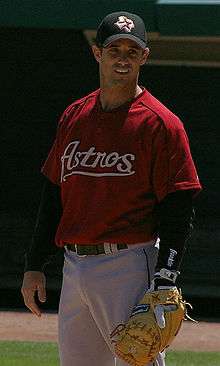 Brad Ausmus, baseball player
Brad Ausmus, baseball player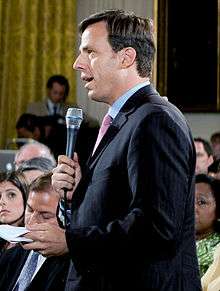 Jake Tapper, journalist, author, and commentator
Jake Tapper, journalist, author, and commentator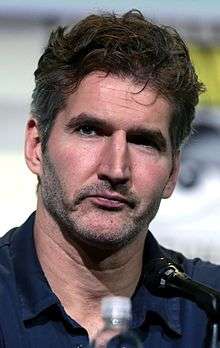 David Benioff, screenwriter and television producer, writer, and director
David Benioff, screenwriter and television producer, writer, and director
In popular culture
Dartmouth College has appeared in or been referenced by a number of popular media. Most notably, the 1978 comedy film National Lampoon's Animal House was co-written by Chris Miller '63,[297] and is based loosely on a series of stories he wrote about his fraternity days at Dartmouth. In a CNN interview, John Landis said the movie was "based on Chris Miller's real fraternity at Dartmouth", Alpha Delta Phi.[298] Dartmouth's Winter Carnival tradition was the subject of the 1939 film Winter Carnival starring Ann Sheridan and written by Budd Schulberg '36 and F. Scott Fitzgerald.[193]
References
- "Dartmouth at a Glance". Dartmouth College. Retrieved November 28, 2015.
- Sketches of the alumni of Dartmouth college, Page 108, The New Hampshire Repository, Volumes 1–2, William Cogswell, Publisher: Alfred Prescott, 1846
- As of June 30, 2019. "U.S. and Canadian 2019 NTSE Participating Institutions Listed by Fiscal Year 2019 Endowment Market Value, and Percentage Change in Market Value from FY18 to FY19 (Revised)". National Association of College and University Business Officers and TIAA. Retrieved April 21, 2020.
- "Joseph Helble on Dartmouth, Running, and Becoming Provost". The Dartmouth. 2018.
- "Dartmouth at a Glance". Trustees of Dartmouth College. Retrieved October 6, 2019.
- "Common Data Set 2019–2020" (PDF). Dartmouth College. Retrieved March 13, 2020.
- "Color Palette". Dartmouth College Office of Communications. October 25, 2018. Retrieved March 6, 2019.
- "About Dartmouth: Facts". Dartmouth College. Archived from the original on May 27, 2008. Retrieved August 23, 2008.
- Childs, Francis Lane (December 1957). "A Dartmouth History Lesson for Freshman". Dartmouth Alumni Magazine. Retrieved February 12, 2007.
- "About Dartmouth – History". Dartmouth.edu. Archived from the original on September 28, 2010. Retrieved October 15, 2010.
- Hoefnagel, Dick; Virginia L. Close (2002). Eleazar Wheelock and the Adventurous Founding of Dartmouth College. Hanover, New Hampshire: Durand Press for Hanover Historical Society.
- Sayigh, Aziz G.; Boris V. Vabson (October 1, 2006). "The Wheelock Succession". The Dartmouth Review. Archived from the original on October 23, 2007. Retrieved August 23, 2008.
- "The World's Most Enduring Institutions" (PDF). Booz Allen Hamilton. December 16, 2004. Archived from the original (PDF) on February 7, 2017. Retrieved August 23, 2008.; "Dartmouth College went from a floundering, financially weak institution of about 300 students over the next 20 years to an enrollment of more than 2,000, a robust endowment, and a national reputation as the most prestigious undergraduate college in the United States."
- "Dartmouth College". Encyclopædia Britannica. Retrieved November 18, 2014.
Dartmouth is regarded as one of the most innovative liberal arts colleges in the United States. The school concentrates primarily on undergraduate education with small classes, numerous seminars, and close student-teacher contact, but Dartmouth is also well known for the quality of its professional schools ...
- "Dartmouth College". Encyclopedia.com.
Building on the strong foundations and rich traditions laid down by the Wheelocks, Nathan Lord and his successors embarked on a broad program of expansion that, before the end of the century, gave Dartmouth a greatly increased endowment, additional buildings, an observatory, and a strong faculty. It was not until the twentieth century that Dartmouth experienced its greatest growth. After the 1890s, the number of students increased tenfold, stabilizing at about three thousand by the mid-1900s. Endowment, faculty, and the physical plant increased accordingly. A center for the arts, facilities for graduate work in a number of fields, and an extensive research library were added.
- "Departments & Programs—Arts & Sciences". Dartmouth College. Retrieved September 13, 2016.
- "Dartmouth College: At a Glance". U.S. News & World Report. Archived from the original on September 18, 2007. Retrieved September 19, 2007.
- "College admits 8.8 percent of applicants to Class of 2024". The Dartmouth. Retrieved April 14, 2020.
- "Explore the Green". Dartmouth College. Retrieved June 15, 2017.
- "A Flexible Study Plan". Dartmouth College. Retrieved September 13, 2016.
- Webster, Katharine (May 25, 2007). "Conservatives Gain Ground at Dartmouth: Dartmouth Alumni Elect Conservatives to Trustees Amid Struggle to Change College's Direction". Washington Post. Associated Press. Retrieved October 21, 2011.
- Kennedy, Randy (November 7, 1999). "A Frat Party Is:; a) Milk and Cookies; b) Beer Pong". The New York Times. Retrieved August 23, 2008.
... at Dartmouth College a place where traditions die hard ...
- "Hill Winds, Granite Brains, and Other Dartmouth Traditions". Summer 2007 Newsletter. Dartmouth Parents & Grandparents. Archived from the original on July 6, 2008. Retrieved August 23, 2008.
- "Dartmouth College". US News & World Report. Retrieved September 12, 2017.
- "Top 10 Best Value Schools". US News & World Report. Retrieved September 5, 2017.
- "Dartmouth College". Forbes. Retrieved November 25, 2016.
- "Dartmouth College". Times Higher Education (THE). Retrieved November 25, 2016.
- "Dartmouth College". Niche. Retrieved June 15, 2017.
- "Dartmouth College". Princeton Review. Retrieved June 19, 2017.
- "Top 25 Private Colleges In The U.S. 2017". forbes.com. Forbes. Retrieved August 2, 2017.
- "10 Expensive Colleges Worth Every Penny 2017". forbes.com. Forbes. Retrieved April 26, 2016.
- "The 28 Schools That Mint The Most Billionaire Alumni". forbes.com. Forbes. Retrieved July 6, 2017.
- "These 20 Colleges Produce The Most Millionaire Alumni". forbes.com. Forbes. Retrieved August 18, 2016.
- "2017 Grateful Grads Index: Top 200 Best-Loved Colleges". forbes.com. Forbes. Retrieved August 2, 2017.
- "Dartmouth Tops the Ivy League in Nature's 2017 Innovation Index". news.dartmouth.com. Dartmouth College. Retrieved August 9, 2017.
- "Top Colleges Doing the Most for the American Dream". New York Times. Retrieved May 25, 2017.
- "The Best Universities For Undergraduate Teaching". huffingtonpost.com. Huffington Post. Retrieved January 19, 2014."Dartmouth College is the best university for undergraduate teaching ... still. For the fifth year in a row, Dartmouth was named No. 1 in U.S. News & World Report's ranking of universities that offer the best undergraduate teaching."
- Solmon, Lewis C; Astin, Alexander W (July 9, 2010). "A New Study of Excellence in Undergraduate Education". Change: The Magazine of Higher Learning. 13 (6): 22. doi:10.1080/00091383.1981.9936972.; "As shown by its high placement in annual U.S. News & World Report rankings, Dartmouth's commitment to undergraduate education is top-notch, the college offering unique academic and research opportunities for students during their course of study while achieving the highest levels of distinction in the discovery and transmission of knowledge and understanding. Besides Princeton, Dartmouth truly lays claim to being America's preeminent undergraduate institution and the world's first "research college".
- "The Carnegie Foundation Classification of Institutions of Higher Learning, Dartmouth College". carnegieclassifications.iu.edu. Retrieved February 1, 2016.
- "Dartmouth alumni seek national, state political offices". The Dartmouth. Retrieved April 14, 2016.
- "Top 20 colleges with most billionaire alumni". CNN. September 16, 2014. Retrieved September 17, 2014.
- "Sarah Waltcher '16 Named Rhodes Scholar". Dartmouth Now. Retrieved November 21, 2016.
- "Statistics". Marshallscholarship.org. Retrieved December 7, 2017.
- "Heidi Williams '03 Named MacArthur 'Genius'". Dartmouth Now. Archived from the original on January 15, 2016. Retrieved January 15, 2016.
- "Fifteen students named Fulbright scholars". The Dartmouth. Retrieved May 10, 2017.
- Hoefnagel, Dick; Virginia L. Close (November 1999). "Eleazar Wheelock's Two Schools". Dartmouth College Library Bulletin. Retrieved August 23, 2008.
- "Samson Occom". Christian History Institute. Archived from the original on April 7, 2008. Retrieved August 23, 2008.
- "Rauner Library Blog: Is This Cricket?". Dartmouth College Library. January 29, 2010. Retrieved February 10, 2010.
- Black Alumni of Dartmouth Association (2019). "Dartmouth Black Students from the 18th to Mid-20th Century". Retrieved August 20, 2019.
- "The Graduation of Dartmouth's First Black Student". Dartmouth College.
- "University Chronology | University of New Hampshire Library". Unh.edu. Retrieved December 7, 2017.
- "Many Bequests to Charity; Will of Dr. Ordronaux D ..." (PDF). The New York Times. March 29, 1908. Retrieved February 20, 2009.
- "William Jewett Tucker". Office of the President. Retrieved August 23, 2008.
- "17 Aug 1945, Page 6 - The Wisconsin Jewish Chronicle at Newspapers.com". Newspapers.com. Retrieved May 28, 2018.
- Eric F. Goldman, The Crucial Decade: America, 1945–1955, (New York: Knopf, 1956), p. 42: "... and Dartmouth's president, Ernest Hopkins, blandly explained that of course his college admitted only a quota of Jews."
- "John Sloan Dickey". Office of the President. Retrieved August 23, 2008.
- "The Wheelock Succession of Dartmouth Presidents: John G. Kemeny, 1970–1981". Dartmouth News. Archived from the original on September 8, 2008. Retrieved May 12, 2008.
- "When did Dartmouth become co-educational?". AskDartmouth. Dartmouth College. Archived from the original on June 25, 2007. Retrieved August 23, 2008.
- Kaminer, Ariel (September 24, 2013). "Rutgers Updates Its Anthem to Include Women". The New York Times.
- "James O. Freedman". Office of the President. Retrieved August 23, 2008.
- Coburn, Michael (January 23, 2008). "Capital campaign hits $1 billion benchmark". The Dartmouth. Archived from the original on July 6, 2008. Retrieved February 5, 2008.
- Santo, JR (May 4, 2007). "65 percent done, $1.3 billion capital campaign right on track". The Dartmouth. Archived from the original on February 17, 2008. Retrieved February 5, 2008.
- "Current Capital Projects". Office of Planning, Design & Construction. Retrieved February 5, 2008.
- Schpero, William (September 19, 2007). "Battle for Board leaves boardroom". The Dartmouth. Archived from the original on July 23, 2008. Retrieved August 23, 2008.
- Lowe, Allie (February 4, 2008). "President Wright to step down in June 2009". The Dartmouth. Archived from the original on February 8, 2008. Retrieved February 5, 2008.
- "Dr. Jim Yong Kim appointed 17th President of Dartmouth College" (Press release). Dartmouth College. March 2, 2009. Archived from the original on April 6, 2009. Retrieved March 2, 2009.
- "Members of the Matariki Network of Universities". Matarikinetwork.com. Retrieved October 15, 2010.
- Fernandes, Deirdre (August 6, 2019). "Dartmouth College settles sex harassment suit for $14 million". The Boston Globe. Retrieved August 7, 2019.
- "Three Leading Research Universities Join the Association of American Universities (AAU)". www.aau.edu. Retrieved March 5, 2020.
- "About Dartmouth". Archived from the original on January 18, 2012. Retrieved February 27, 2012.
- "Undergraduate Majors". Dartmouth College. Archived from the original on May 29, 2008. Retrieved August 23, 2008.
- Blumberg, Joseph (June 9, 2017). "Commencement Notes for the Dartmouth Class of 2017". Dartmouth News. Retrieved December 12, 2017.
- Hix, Simon (2004). "A Global Ranking of Political Science Departments" (PDF). Political Studies Review. 2: 293–313. Archived from the original (PDF) on December 21, 2004. Retrieved December 21, 2004.
- Kalaitzidakis, Pantelis; Mamuneas, Theofanis P.; Stengos, Thanasis (June 2003). "Rankings of Academic Journals and Institutions in Economics" (PDF). University of Guelph. Archived from the original (PDF) on August 21, 2010. Retrieved December 28, 2010.
- "Requirements for the Degree of Bachelor of Arts". Office of the Registrar. Retrieved August 23, 2008.
- "Programs – List All". Off-Campus Programs. Archived from the original on December 9, 2008. Retrieved August 23, 2008.
- "Types of Programs". Off-Campus Programs. Archived from the original on October 13, 2008. Retrieved August 23, 2008.
- "Academics & Research". Dartmouth College. Archived from the original on June 15, 2008. Retrieved August 23, 2008.
- "About UPNE". University Press of New England. Retrieved March 4, 2009.
- "Academic Ranking of World Universities 2020: National/Regional Rank". Shanghai Ranking Consultancy. Retrieved August 15, 2020.
- "America's Top Colleges 2019". Forbes. Retrieved August 15, 2019.
- "U.S. College Rankings 2020". Wall Street Journal/Times Higher Education. Retrieved September 26, 2019.
- "Best Colleges 2020: National University Rankings". U.S. News & World Report. Retrieved September 8, 2019.
- "2019 National University Rankings". Washington Monthly. Retrieved August 20, 2019.
- "Academic Ranking of World Universities 2020". Shanghai Ranking Consultancy. 2020. Retrieved August 15, 2020.
- "QS World University Rankings® 2021". Quacquarelli Symonds Limited. 2020. Retrieved June 10, 2020.
- "World University Rankings 2020". THE Education Ltd. Retrieved September 14, 2019.
- "Best Global Universities Rankings: 2020". U.S. News & World Report LP. Retrieved October 22, 2019.
- "Dartmouth College – U.S. News Best Grad School Rankings". U.S. News & World Report. Retrieved August 1, 2019.
- "Dartmouth College Rankings". U.S. News & World Report. 2020. Retrieved September 11, 2019.
- "'U.S. News': Dartmouth Again No. 1 for Teaching, Top 10 Overall | Dartmouth News". news.dartmouth.edu. Retrieved July 2, 2020.
- "America's Top Colleges 2019". Forbes. August 15, 2019.
- Hansen, Sarah (August 21, 2018). "Grateful Grads 2018 – 200 Colleges With The Happiest, Most Successful Alumni". Forbes.
- "Academic Ranking of World Universities 2018". www.shanghairanking.com. Retrieved August 1, 2019.
- Bahram Bekhradnia (December 15, 2016). "International university rankings: For good or ill?" (PDF). Higher Education Policy Institute. p. 16. Retrieved June 10, 2017.
ARWU presents a further data issue. Whereas in the case of the other rankings the results are adjusted to take account of the size of institutions, hardly any such adjustment is made by ARWU. So there is a distortion in favour of large institutions. If two institutions were to merge, the very fact of merger would mean that the merged institution would do nearly twice as well as either of the individual institutions prior to merger, although nothing else had changed.
- "Dartmouth college fares poorly in international rankings". Ivy Coach. Retrieved December 31, 2019.
- "Carnegie Classifications | Institution Profile". Classifications.carnegiefoundation.org. Retrieved October 15, 2010.
- "The Carnegie Classification of Institutions of Higher Education". The Carnegie Foundation for the Advancement of Teaching. Archived from the original on August 22, 2008. Retrieved August 23, 2008.
- "Classifications: Dartmouth College". The Carnegie Foundation for the Advancement of Teaching. Archived from the original on October 13, 2007. Retrieved August 23, 2008.
- "Class of 2023 Sets New Milestones | Dartmouth News". news.dartmouth.edu. Retrieved October 7, 2019.
- "Data set" (PDF). www.dartmouth.edu.
- "Dartmouth College". U.S. News & World Report. Archived from the original on September 17, 2016. Retrieved September 13, 2016.
- "The Carnegie Classification of Institutions of Higher Education: Four-year, full-time, most selective, lower transfer-in (2015) | Carnegie Classification".
- "Dartmouth College". The Princeton Review. Retrieved September 13, 2016.
- "Dartmouth admits 8.8 percent of applicants to Class of 2024". The Dartmouth.
- "Data set" (PDF). www.dartmouth.edu.
- "College ends need-blind admission for international students". Archived from the original on September 29, 2015. Retrieved September 28, 2015.
- Aisch, Gregor; Buchanan, Larry; Cox, Amanda; Quealy, Kevin (January 18, 2017). "Economic diversity and student outcomes at Dartmouth". The New York Times. Retrieved August 9, 2020.
- "D-Plan". Admissions and Financial Aid. Retrieved August 23, 2008.
- "Petition for Change in Enrollment Pattern" (PDF). Dartmouth. Retrieved July 23, 2014.
- "Working Rules and Procedures". Office of the Registrar. Retrieved August 23, 2008.
- "Dartmouth Trustees vote to expand size of board". Dartmouth News. November 17, 2003. Archived from the original on October 13, 2008. Retrieved August 23, 2008.
- "Board of trustees vote to change how Dartmouth College is run". The Boston Globe. Associated Press. September 7, 2007. Retrieved August 20, 2008.
- Schpero, William (September 8, 2007). "Board adds 8 seats, ends century-old parity". The Dartmouth. Archived from the original on March 7, 2008. Retrieved August 23, 2008.
- Schpero, William (August 20, 2008). "Divided Association of Alumni sues College". The Dartmouth. Archived from the original on October 2, 2008. Retrieved August 23, 2008.
- "Lawsuit against College dismissed". TheDartmouth.com. June 27, 2008. Archived from the original on September 26, 2013. Retrieved September 22, 2013.
- College, Dartmouth (September 5, 2008). "Dartmouth College's Board of Trustees Elects Five Alumni as New Trustees". Press Release. Archived from the original on September 12, 2008. Retrieved October 3, 2008.
- Clinton, William J. (June 11, 1995). "Remarks at the Dartmouth College Commencement Ceremony in Hanover, New Hampshire". The American Presidency Project. Archived from the original on December 7, 2008. Retrieved August 23, 2008.
- "The Campus". Dartmouth College. Archived from the original on June 15, 2008. Retrieved August 23, 2008.
- "The Green". Dartmo.: The Buildings of Dartmouth College. Archived from the original on February 8, 2005. Retrieved August 23, 2008.
- "Open Space Priorities Plan Summary". Planning and Zoning Department of the Town of Hanover, New Hampshire. Archived from the original on January 14, 2012. Retrieved October 21, 2011.
- "2005 Form 990" (PDF). GuideStar.org. Retrieved August 23, 2008.
- Dartmouth Outing Guide p. 56.
- "Second College Grant". Dartmouth Outing Club. Retrieved August 20, 2008.
- "Kemeny Hall and Haldeman Center". Office of Planning, Design, and Construction. Archived from the original on July 25, 2008. Retrieved August 23, 2008.
- "McLaughlin Cluster Residence Halls". Office of Planning, Design, and Construction. Archived from the original on September 17, 2008. Retrieved August 23, 2008.
- "CIC Historic Campus Architecture Project" (PDF). The Council of Independent Colleges. Archived from the original (PDF) on June 25, 2008. Retrieved August 23, 2008.
- "Atkin Olshin Lawson-Bell Architects". Dartmo.: The Buildings of Dartmouth College. Retrieved August 23, 2008.
- Thelin, John R. (2004). A History of American Higher Education. Johns Hopkins University Press. ISBN 978-0-8018-7855-8.
- "Dartmouth Landscape Design Guidelines". Saucier + Flynn Landscape Architects. Archived from the original on October 17, 2007. Retrieved August 23, 2008.
- "Dartmouth Sustainability Initiative". Dartmouth College. Retrieved May 21, 2008.
- "College Sustainability Report Card 2008". Sustainable Endowments Institute. Retrieved May 21, 2008.
- "Old Growth – Dartmouth's elms endure as defining features of the campus". Dartmouth College website, Dartmouth Life Home. June 2007. Retrieved December 26, 2014.
The College's claim on the landscape began with the felling of the great white pines that grew on the plain above the Connecticut River; planting came later. By the middle of the 19th century, villages and towns throughout New England—and eventually across the nation—were shading their streets with the American elm, Ulmus americana. A circa 1840 watercolor image of the College depicts graceful young elms edging the Green. "If you look at pictures of old Hanover," says John Gratiot, associate vice president for Facilities Operations and Management, "Main Street and College Street were completely lined with elms, like a green tunnel."
- "50 Trees in 50 Minutes". Dartmouth College website, The Graduate Forum. October 1, 2014. Archived from the original on January 4, 2015. Retrieved December 26, 2014.
- "General Information & History". Hopkins Center for the Arts. Archived from the original on February 25, 2008. Retrieved August 23, 2008.
- Steinert, Tamara (November 4, 2002). "The Hopkins Center Turns 40". Dartmouth News. Archived from the original on October 11, 2008. Retrieved August 23, 2008.
- "Undergraduate Student Mail". Facilities Operations and Management. Retrieved August 23, 2008.
- "Dining Locations: Courtyard Café". Dartmouth Dining Service. Archived from the original on October 31, 2007. Retrieved August 23, 2008.
- "Dartmouth College: Services and Facilities". U.S. News and World Report. Archived from the original on February 25, 2008. Retrieved September 17, 2007.
- "The Arts". Graduate Studies. Archived from the original on January 27, 2012. Retrieved October 21, 2011.
- "Maps and Directions". Dartmouth Medical School. Retrieved August 23, 2008.
- "Dartmouth Maps". Dartmouth College. Retrieved August 23, 2008.
- "About Dartmouth-Hitchcock Medical Center". Dartmouth-Hitchcock Medical Center. Archived from the original on January 17, 2008. Retrieved August 23, 2008.
- "Our Campus". Tuck School of Business. Archived from the original on June 15, 2008. Retrieved August 23, 2008.
- "Library Holdings" (PDF). Dartmouth College Fact Book. Retrieved August 23, 2008.
- "About Baker-Berry Library". Dartmouth College. Retrieved November 11, 2015.
- "Baker Library Bell Tower". Dartmouth College Libraries. Retrieved March 14, 2009.
- Santos, Nicholas J (September 17, 2004). "No Bridge Left Unburned: Rage at Dartmouth". The Dartmouth Free Press. Archived from the original on October 13, 2007. Retrieved August 23, 2008.
- "Dartmouth College's Berry/Baker Library" (PDF). The Observer. New Hampshire Society of Professional Engineers. February 2003. Archived from the original (PDF) on June 25, 2008. Retrieved August 23, 2008.
- "Dartmouth College Athletic Facilities". Dartmouth Sports. Archived from the original on December 8, 2008. Retrieved August 23, 2008.
- "Alumni Gym". Dartmouth Sports. Archived from the original on December 8, 2008. Retrieved August 23, 2008.
- "Berry Sports Center". Dartmouth Sports. Archived from the original on December 10, 2008. Retrieved August 23, 2008.
- "Memorial Field". Dartmouth Sports. Archived from the original on December 8, 2008. Retrieved August 23, 2008.
- "Thompson Arena". Dartmouth Sports. Retrieved August 23, 2008.
- "History". Hanover Country Club. Archived from the original on July 25, 2008. Retrieved August 23, 2008.
- Monahan, Thomas. "Rugby Fires It Up With New Clubhouse". The Dartmouth Review. Archived from the original on November 18, 2007. Retrieved August 23, 2008.
- "Dartmouth Skiway". Dartmouth College. Retrieved August 23, 2008.
- "2013 IHSA Awards brochure" (PDF). Archived from the original (PDF) on September 28, 2013. Retrieved September 22, 2013.
- "College Unveils Six House Communities to Open Next Fall". Dartmouth College. November 2, 2015. Archived from the original on April 20, 2016. Retrieved April 23, 2016.
- "Introduction: Housing on Campus". Office of Residential Life. Retrieved August 23, 2008.
- O'Donnell, Katy (January 18, 2006). "Assembly reworks UFC membership guidelines". The Dartmouth. Archived from the original on October 19, 2014. Retrieved August 23, 2008.
- "Campus Map". Dartmouth Dining Services. Archived from the original on December 29, 2007. Retrieved August 23, 2008.
- "Dining Locations". Dartmouth Dining Services. Retrieved September 19, 2007.
- "Collis Center". Collis Center & Student Activities Office. Retrieved August 23, 2008.
- "Collis Floor Plans". Collis Center & Student Activities Office. Retrieved August 23, 2008.
- "Administrative Departments in Collis Center". Collis Center & Student Activities Office. Retrieved August 23, 2008.
- "Robinson Hall". Collis Center & Student Activities Office. Retrieved August 23, 2008.
- The Princeton Review (2006). Best 361 Colleges. New York, NY: Princeton Review Press.
- "Student Life". Admissions and Financial Aid. Retrieved August 23, 2008.
- "Dartmouth College – The Princeton Review College Rankings & Reviews". www.princetonreview.com.
- Anderson, Nick (June 7, 2016). "These colleges have the most reports of rape" – via www.washingtonpost.com.
- Janet Reitman, "Confessions of an Ivy League Frat Boy: Inside Dartmouth's Hazing Abuses", Rolling Stone, April 12, 2012
- Richard Perez-Pena, "Dartmouth in the Glare of Scrutiny on Drinking", New York Times, October 2, 2013
- "Campus Life: Clubs and Organizations". Dartmouth College. Retrieved August 23, 2008.
- "COSO Student Organizations". Collis Center and Student Activities Office. Retrieved August 23, 2008.
- Collins, Jim (December 2009). "100 Years of the Dartmouth Outing Club". The Dartmouth Alumni Magazine. Hanover, NH: Dartmouth College (November–December 2009): 38. ISSN 2150-671X.
- "Big Green Bus in the News". The Big Green Bus. Archived from the original on September 28, 2011. Retrieved June 5, 2010.
- Longman, Phillip (February 14, 1988). "Reagan's Disappearing Bureaucrats". The New York Times. Retrieved August 23, 2008.
- "The Dartmouth". The Dartmouth. Retrieved January 27, 2008.
- Meacham, Scott. "Halls, Tombs and Houses: Student Society Architecture at Dartmouth". Dartmo.: The Buildings of Dartmouth College. Retrieved August 23, 2008.
- "Coed, Fraternity, and Sorority Administration". Office of Residential Life. Retrieved August 23, 2008.
- "History of CFS Organizations at Dartmouth". Greek Leadership Council. Archived from the original on February 18, 2008. Retrieved August 23, 2008.
- Hill, Ralph Nading (1965). The College on the Hill: A Dartmouth Chronicle. Hanover, New Hampshire: Dartmouth Publications. pp. 259–260. LCCN 65002598.
- Wellman, Stephan (March 1999). "Dartmouth to Abolish Fraternities and Sororities". Accuracy in Academia. Archived from the original on October 13, 2007. Retrieved August 23, 2008.
- Rago, Joseph (January 30, 2005). "Interrogating the S.L.I." The Dartmouth Review. Archived from the original on October 23, 2007. Retrieved August 23, 2008.
- "Mirror at the End of the Tunnel". October 5, 2012. Archived from the original on November 21, 2014. Retrieved December 2, 2014.
- "Senior and Undergraduate Society Administration". Office of Residential Life. Retrieved August 23, 2008.
- "What percentage of Dartmouth students play a varsity sport?". Ask Dartmouth. Dartmouth College. Retrieved September 23, 2008.
- "About Dartmouth Athletics". Dartmouth Sports. Archived from the original on December 8, 2008. Retrieved August 23, 2008.
- "What is the Ivy League?". Ivy League Sports. Archived from the original on April 28, 2008. Retrieved August 23, 2008.
- "Club Sports". Dartmouth Sports. Archived from the original on December 8, 2008. Retrieved August 23, 2008.
- "Club fencing takes first national title". Archived from the original on January 3, 2015. Retrieved January 3, 2015.
- "Dartmouth Men". Ivy Rugby Conference. Retrieved November 11, 2015.
- "Dartmouth Wins Fourth Consecutive National Title". Dartmouth Figure Skating Team. March 27, 2007. Retrieved August 23, 2008.
- "General Academic Requirements for Graduation". First Year Office. Retrieved October 21, 2011.
- "The Charter of Dartmouth College". Dartmo.com. Retrieved August 23, 2008.
- "About the Native American Program". Native American Program. Retrieved August 23, 2008.
- Wald, Matthew L (July 20, 1987). "15th President Installed at Dartmouth". The New York Times. Retrieved August 23, 2008.
- Herbert, Stephanie (May 19, 2006). "Steph's So Dartmouth". The Dartmouth. Archived from the original on November 19, 2008. Retrieved August 23, 2008.
- "The Dartmouth Green: A Walking Tour of Dartmouth". Dartmouth College. Archived from the original on October 13, 2007. Retrieved August 23, 2008.
- Mehta, Chetan (February 10, 2006). "Hopkins Center offers many alternatives over weekend". The Dartmouth. Archived from the original on December 7, 2008. Retrieved August 23, 2008.
- Rago, Joseph (October 21, 2005). "A History of Homecoming". The Dartmouth Review. Archived from the original on October 13, 2007. Retrieved August 23, 2008.
- "Winter Carnival: Stories of the Mardi Gras of the North". The Dartmouth Review. February 11, 2007. Archived from the original on October 23, 2007. Retrieved August 23, 2008.
- "Winter carnival to be held | News | Bates College". www.bates.edu. January 13, 1997. Retrieved February 7, 2016.
- "Green Key History: Those Were the Days". The Dartmouth Review. May 11, 2004. Archived from the original on October 23, 2007. Retrieved August 23, 2008.
- Fisher, Samuel. "Town, College Weigh Tubestock Changes". The Dartmouth Review. Archived from the original on October 23, 2007. Retrieved August 23, 2008.
- Garfinkel, Jennifer (July 26, 2006). "Fieldstock, chariots await town approval". The Dartmouth. Archived from the original on December 7, 2008. Retrieved August 23, 2008.
- "About the Program". Dartmouth Outing Club. Retrieved August 23, 2008.
- "Out of the Woods". Time. November 23, 1962. Retrieved August 23, 2008.
- Good, Jonathan (April 1997). "Notes from the Special Collections: The Dartmouth College Seal". Dartmouth College Library Bulletin (NS 37). Retrieved August 23, 2008.
- "Bartlett Hall's Wheelock Memorial Window". Dartmo.: The Buildings of Dartmouth College. Retrieved August 23, 2008.
- "Follow-up on the news; Song out of tune with the times". The New York Times. March 1, 1987. Retrieved January 7, 2008.
- Krieger, Barbara L. "The Alma Mater". Dartmouth College Library Rauner Special Collections Library. Archived from the original on January 16, 2008. Retrieved January 7, 2008.
- Dartmouth College, Trustees' Records, 1:26. Dartmouth College Library, Special Collections, DA-1.
- "United States Patent and Trademark Office". Retrieved August 23, 2008.
- Good, Jonathan. "A Proposal for a Heraldic Coat of Arms for Dartmouth College". Dartmo. Retrieved December 2, 2010.
- Nabity, Joe. "Nanometer Pattern Generation System: Dartmouth Seal". Dartmouth College. Retrieved August 23, 2008.
- "Is "The Big Green" really Dartmouth's mascot? If so, where does it come from and what does it mean?". AskDartmouth. Dartmouth College. Retrieved August 23, 2008.
- "The". Archived from the original on May 7, 2016. Retrieved September 10, 2016.
- "Why is green Dartmouth's color?". AskDartmouth. Dartmouth College. Retrieved August 23, 2008.
- Chase, Frederick; John King Lord (1913). A History of Dartmouth College and the Town of Hanover, New Hampshire, Volume 2 (1 ed.). Concord, N.H.: J. Wilson, The Rumford Press. p. 373.
- "The 'Big Green' Nickname". DartmouthSports.com. January 10, 2007. Retrieved August 23, 2008.
- Beck, Stefan M (June 8, 2003). "Dartmouth Indians: The New Tradition". The Dartmouth Review. Archived from the original on December 27, 2007. Retrieved August 23, 2008.
- Hart, Jeffrey (December 15, 1998). "The Banning of the Indian". The Dartmouth Review. Archived from the original on December 27, 2007. Retrieved August 23, 2008.
- Blodget, Kelsey (January 5, 2007). "Straight from the Tap: the men behind the mascot". The Dartmouth. Archived from the original on October 13, 2007. Retrieved August 23, 2008.
- Buck, Caroline (April 29, 2010). "It's not easy being Green". The Dartmouth. Archived from the original on January 27, 2012. Retrieved October 21, 2011.
- Lowe, Allie (January 10, 2007). "First SA meeting draws crowd". The Dartmouth. Archived from the original on October 29, 2007. Retrieved January 24, 2007.
- Jaschik, Scott (September 10, 2007). "Dartmouth Approves Controversial Board Changes". Inside Higher Education. Retrieved August 23, 2008.
- Needleman, Sarah E. (July 31, 2008). "Ivy Leaguers' Big Edge: Starting Pay". The Wall Street Journal. Retrieved August 2, 2008.
- Ghods-Esfahani, Emily (October 11, 2006). "The Alumni Constitution, in Brief". The Dartmouth Review. Archived from the original on October 13, 2007. Retrieved August 23, 2008.
- "Members of Congress". Dartmouth Club of Washington, D.C. Retrieved December 10, 2006.
- "Amos T. Akerman". The New Georgia Encyclopedia. Retrieved August 23, 2008.
- "Leading Voices Lecturer: Robert Reich '68". Dartmouth College. July 20, 2011. Archived from the original on April 6, 2012. Retrieved October 21, 2011.
- "C. Everett Koop". United States Department of Health & Human Services. Archived from the original on December 9, 2006. Retrieved August 23, 2008.
- "Salmon P. Chase". Tulane University. Archived from the original on December 31, 2006. Retrieved August 23, 2008.
- "Levi Woodbury". Oyez Supreme Court Media. Retrieved December 10, 2006.
- O'Toole, James (October 12, 2014). "As Tom Wolf seeks the Pennsylvania governor's office, political life comes full circle". Pittsburgh Post-Gazette. Retrieved January 20, 2015.
- Pearson, Rick (November 5, 2014). "Bruce Rauner, political rookie, rises to claim governorship". Chicago Tribune. Retrieved January 9, 2018.
- Curtis, Meredith (Fall 2004). "Wall Street, Aneurysms and Explanatory Writing: An Interview With Thomas Burton '71" (PDF). Dartmouth Undergraduate Journal of Science. Retrieved August 23, 2008.
- "Richard Eberhart". Encyclopædia Britannica. Retrieved December 10, 2006.
- Lee, Fred (April 23, 2014). "Dan Fagin '85 Awarded 2014 Pulitzer Prize for 'Toms River'". Dartmouth Now. Archived from the original on January 15, 2015. Retrieved January 15, 2015.
- "More GreenNews". Dartmouth Office of Alumni Relations. Retrieved November 30, 2008.
Jake Hooker '95: New York Times reporter, wins 2008 Pulitzer Prize for journalism for investigative reporting on the flow of dangerous pharmaceutical ingredients from China into world market. (New York Times)
- "The Pulitzer Prize Winners 2005". The Pulitzer Prizes. Archived from the original on November 14, 2007. Retrieved August 23, 2008.
- "WSJ's Rago Wins Pulitzer Prize". Wall Street Journal. April 19, 2011. Retrieved October 21, 2011.
- "History". The John Sloan Dickey Center for International Understanding. Archived from the original on February 8, 2007. Retrieved November 20, 2007.
- Stavis, Laurel. "Six to receive Social Justice Awards". Vox of Dartmouth. Dartmouth College. Retrieved August 23, 2008.
- Jay Parini (2000). Robert Frost: A Life. Macmillan. pp. 64–65. ISBN 978-0-8050-6341-7.
- Dartmouth News Archived February 6, 2007, at the Wayback Machine, "Dartmouth acquires Budd Schulberg '36 papers"
- "About Dinesh D'Souza". DineshDSouza.com. Retrieved August 23, 2008.
- "Ingraham '85 to speak on election". Dartmouth News. October 6, 2006. Archived from the original on December 9, 2008. Retrieved August 23, 2008.
- "Mort Kondracke". Fox News. September 19, 2006. Archived from the original on September 7, 2008. Retrieved August 23, 2008.
- "James Panero". The New Criterion. Retrieved October 21, 2011.
- Breu, Giovanna (December 13, 1976). "Professor, Outdoorsman, Now a Novelist—Norman Maclean 'Finds Life Again' at 73". People. Retrieved December 7, 2011.
- Smith, Steve (June 5, 2010). "And to Think That It Happened at Dartmouth". The Dartmouth. Archived from the original on September 24, 2011. Retrieved December 7, 2011.
- Lathem, Edward Connery (November 2000). "Who's Who & What's What in the Books of Dr. Seuss". Archived from the original on August 7, 2008. Retrieved August 23, 2008.
- Marsh, James; John J. Duffy (1973). Coleridge's American disciples: the selected correspondence of James Marsh. Univ of Massachusetts Press. p. 128. ISBN 978-0-87023-121-6.
- Persuitte, David (2000). Joseph Smith and the origins of the Book of Mormon (2 ed.). McFarland. p. 277. ISBN 978-0-7864-0826-9.
- Gilman, Marcus (1897). The Bibliography of Vermont: Or, A List of Books and Pamphlets Relating. The Free Press Association. p. 279. OCLC 04072330.
- "Rabbi David E. Stern Endowed Scholarship Established at HUC-JIR". Hebrew Union College. Archived from the original on November 10, 2007. Retrieved February 8, 2010.
- "Rabbi Arnold E. Resnicoff Named National Director of Interreligious Relations". American Jewish Committee (via Charity Wire). October 4, 2001. Archived from the original on July 8, 2011. Retrieved February 8, 2010.
- "Stuart Kauffman". Esalen Center for Theory & Research. Retrieved August 23, 2008.
- "Vita for Dr. Jeffrey Weeks". Division of Mathematics & Science, United States Naval Academy. Archived from the original on October 13, 2007. Retrieved August 23, 2008.
- "Owen Chamberlain". Nobel Foundation. Retrieved August 23, 2008.
- "K. Berry Sharpless curriculum vitae". Scripps College. Retrieved August 23, 2008.
- "George Davis Snell". Encyclopædia Britannica. Archived from the original on October 13, 2007. Retrieved August 23, 2008.
- "Oren B. Cheney". Bates College. Archived from the original on October 15, 2006. Retrieved December 10, 2006.
- "Dartmouth Grad Named New UCSD Chancellor". Dartmouth.edu. Retrieved September 22, 2013.
- Close, Virginia L (April 1993). "Double Play: Women's Education and Anti-Slavery". Dartmouth College Library Bulletin. Retrieved August 23, 2008.
- "Philander Chase". Ohio History Central. Retrieved August 23, 2008.
- Osborne, James Insley; Theodore Gregory Gronert (1932). Wabash College: The First Hundred Years, 1832–1932. Crawfordsville, Indiana: R. E. Banta. p. 31.
- Krieger, Lois A. (2002). "The Woodward Succession: A Brief History of the Dartmouth College Library, 1769–2002". Dartmouth College. Archived from the original on January 18, 2012. Retrieved October 21, 2011.
- "Past Presidents of Union". Union College. Archived from the original on March 19, 2011. Retrieved October 21, 2011.
- "Presidents of Dartmouth College". Rauner Special Collections Library, Dartmouth College. Archived from the original on December 7, 2006. Retrieved December 10, 2006.
- "Richard "Sandy" Alderson, Chief Executive Officer, San Diego Padres". Association for Strategic Planning. Archived from the original on October 13, 2007. Retrieved August 23, 2008.
- "The Networked World: Are We Ready For It?". MIT World. Archived from the original on October 13, 2007. Retrieved August 23, 2008.
- "Dartmouth Board of Trustees Biographies". Retrieved August 23, 2008.
- Eisele, Rob (August 26, 1998). "William Jewell Honors Kansas City Business Leaders with Yates Medal". William Jewell College. Archived from the original on February 12, 2005. Retrieved December 10, 2006.
- "Calif. parent in college bribery scheme appears in Boston court" – The Boston Globe
- Knapp, Sue (April 9, 2004). "GE's Jeffrey Immelt to speak at Dartmouth Entrepreneurship Conference". Dartmouth News. Archived from the original on September 23, 2006. Retrieved August 23, 2008.
- Weeks, Christian (October 5, 2005). "Hank Paulson '68, Business Big Shot". BuzzFlood.
- McLeland, Susan. "Tinker, Grant". Museum of Broadcast Communications. Archived from the original on February 7, 2007. Retrieved March 28, 2007.
- Grimaldi, Paul (May 20, 2008). "In charge at Hasbro". The Providence Journal. Archived from the original on July 9, 2008. Retrieved May 20, 2008.
- "This Grey's Anatomy isn't gross—but it's a textbook case of a hit show". Dartmouth Medical Magazine. Fall 2005. Retrieved December 10, 2006.
- "Dartmouth Alumni in Entertainment and Media Association". Archived from the original on February 12, 2010. Retrieved December 10, 2006.
- "'Mister Rogers' to give Dartmouth Commencement Address". Dartmouth News. May 2, 2002. Archived from the original on October 13, 2007. Retrieved December 10, 2006.
- Garfinkel, Jennifer (January 6, 2005). "Alums bring Fringe fave to Hop". The Dartmouth. Archived from the original on December 7, 2008. Retrieved December 10, 2006.
- Crawford, E.J. "Andrew Shue". Ivy@50. Retrieved December 10, 2006.
- Olshansky, Elliot (May 19, 2003). "Ausmus '91 produces Gold Gloves and success for Astros". The Dartmouth. Archived from the original on November 3, 2005. Retrieved December 10, 2006.
- "Mike Remlinger". ESPN. Retrieved December 10, 2006.
- "Dolphins still winning, Jay Fiedler '94 still standing". BuzzFlood. December 5, 2003. Archived from the original on December 13, 2007. Retrieved December 10, 2006.
- "2004 Greater Flint Afro-American Hall of Fame: Reggie Williams". Flint Public Library. October 25, 2005. Archived from the original on October 13, 2007. Retrieved January 12, 2007.
- "Ivy Football Association To Honor Reggie Williams '76". Big Green Sports. January 12, 2006.
- "Football star Nick Lowery to discuss community service Oct. 29 at Dartmouth". Dartmouth News. October 23, 1998. Archived from the original on October 13, 2007. Retrieved December 10, 2006.
- "Jeff Kemp". Premiere Speakers Bureau. Archived from the original on November 18, 2006. Retrieved December 10, 2006.
- Dougherty, Matt (June 2004). "Sports Roundup". Dartmouth Life. Retrieved August 9, 2007.
- "Adam Nelson". USA Track & Field, Inc. Retrieved December 10, 2006.
- Rose, Jordan (January 9, 2006). "Dartmouth athletes gear up for Olympic competition". The Dartmouth. Archived from the original on March 20, 2012. Retrieved December 10, 2006.
- Mitchell, John (November 13, 2006). "Sports: One on One". The Dartmouth. Archived from the original on April 3, 2012. Retrieved December 10, 2006.
- "Cherie Piper". Big Green Sports. Retrieved December 10, 2006.
- "Gillian Apps". Big Green Sports. Retrieved December 10, 2006.
- "Katie Weatherston". Big Green Sports. Retrieved December 10, 2006.
- Lund, Morten (June 14, 2004). "Dick Durrance, America's Champion". Skiing Heritage Journal. Retrieved October 21, 2011.
- "Pamphlet" (PDF). Dartmouth College. Archived from the original (PDF) on September 27, 2007. Retrieved August 22, 2007.
- "Men's Track & Field Olympians". Big Green Sports. Retrieved December 10, 2006.
- "NCAA Champions from Dartmouth College" (PDF). Ivy League Sports. Archived from the original (PDF) on October 31, 2004. Retrieved December 10, 2006.
- The Canadian Press (August 18, 2008). "Gold in Men's Eight, Bronze in Women's Double, Men's Four". The Sports Network. Archived from the original on May 22, 2011. Retrieved August 18, 2008.
- "Dartmouth 'Animal House' frat loses appeal to stay on campus". Retrieved September 10, 2016.
- "Interview with John Landis". CNN. August 29, 2003. Retrieved February 12, 2007.
Further reading
- Behrens, Richard K., "From the Connecticut Valley to the West Coast: The Role of Dartmouth College in the Building of the Nation," Historical New Hampshire, 63 (Spring 2009), 45–68.
- Chase, Frederick; John King Lord (1913). A History of Dartmouth College and the Town of Hanover, New Hampshire, Volume 2 (1 ed.). Concord, N.H.: J. Wilson, The Rumford Press. OCLC 11267716. (Read and download public domain copy via Google Books.)
- Drake, Chuck (2004). Dartmouth Outing Guide (Fifth ed.). Dartmouth Outing Club.
- Graham, Robert B. (1990). The Dartmouth Story: A Narrative History of the College Buildings, People, and Legends. Dartmouth Bookstore.
- Glabe, Scott L. (2005). Dartmouth College: Off the Record. College Prowler. ISBN 978-1-59658-038-1.
- Hughes, Molly K.; Susan Berry (2000). Forever Green: The Dartmouth College Campus—An arboretum of Northern Trees. Enfield Books. ISBN 978-1-893598-01-0.
- Richardson, Leon B. (1932). History of Dartmouth College. Dartmouth College Publications. OCLC 12157587.
- Listen, Look, Likeness: examining the portraits of Félix de la Concha 2009 ArtsEditor.com article
External links
| Wikisource has original text related to this article: |
| Wikimedia Commons has media related to Dartmouth College. |
| Wikiquote has quotations related to: Dartmouth College |
